
It’s an age-old question—and sometimes fuel for an argument: Which carburetors are better, SU or Weber? The answer is elusive. Everyone has an opinion, but no one seems to be able to offer definitive proof.
We set out to find some concrete answers by measuring a couple of mule en…
Read the rest of the story

wspohn
SuperDork
8/13/20 1:19 p.m.
Good article. It is particularly true that on siamesed port engines the benefits of Webers are low and given that new Webers come set up for some other application and the tuning to your engine is a combination of experience and science that most owners lack, it really isn't that attractive a mod except to those who desire the look of the Webers for bragging rights.
Go to one intake port per cylinder and things shift a bit more toward the Webers and it becomes worth the exercise to fit and tune them for a street performance car or a race car (I have always used Webers only on my race cars powered by MG engines).
MG engine with after market 4 port crossflow head:
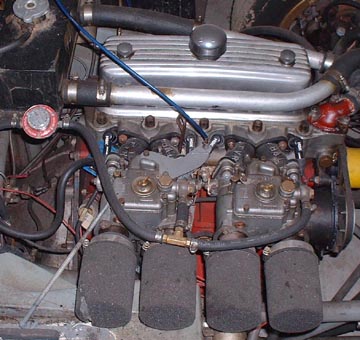
MG engine with factory DOHC head:
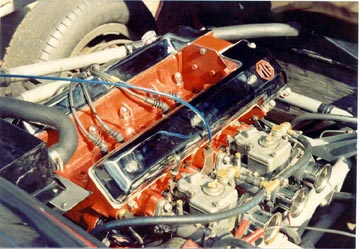

dougie
Reader
8/13/20 11:10 p.m.
Would have been nice to see some test results on the SU 2" HD8's. Tuning on the dyno is the only way to accurately tune any performance motor.

https://youtu.be/8CmGFL54VlA
I've worked with SU's and Webers. Lucky enought to live close to Pierce Manifolds for my Datsun 240Z setup. Webers let me tweak settings as I add modifications or change my driving style. Jets x 6 are not cheap, so getting good advice from folks running similar modifications saves $$ and time.

wspohn
SuperDork
8/15/20 2:37 p.m.
Dougie - the BMC factory was in the habit of speccing too large SUs for racing. The Healey didn't need 2", nor did the race MGB, nor the street Rover 2000 TC. They even tried them on the factory MGA Twin Cam race cars. Flow is too slow at part throttle and they don't run well except on wide open throttle, and even then only when tuned exactly right. I have tried them on my race cars (up to 1950 cc MGB motors) and prefer the 1 3/4" . It gets you little to have a horsepower or two more at top rpm if you lost time getting there.
Sam - we are lucky to have local shops that specialize in Italian cars and keep full sets of jets that they will charge a fee for plus whatever it costs to replace stock once you know what you need. I am lucky that I never had to do anything but fine tuning on my V12 Lamborghini, but that would have been the way to go.
IIRC the Datsun wasn't homologated with Webers but with Solex PHH 44s, but that's pretty much the same thing except for jet availability. We had local racers that got them properly set up and they were one sweet set up once they got them optimized!

dougie
Reader
8/17/20 9:03 p.m.
wspohn said:
Dougie - the BMC factory was in the habit of speccing too large SUs for racing. The Healey didn't need 2", nor did the race MGB, nor the street Rover 2000 TC. They even tried them on the factory MGA Twin Cam race cars. Flow is too slow at part throttle and they don't run ell except on wide open throttle, and even then only when tuned exactly right. I have tried them on my race cars (uop to 1950 cc MGB motors) and prefer the 1 3/4" . It gets you little to have a horsepower or two more at top rpm if you lost time getting there.
Sam - we are lucky to have local shops that specialize in Italian cars and keep full sets of jets that they will charge a fee for plus whatever it costs to replace stock once you know what you need. I am lucky that I never had to do anything but fine tuning on my V12 Lamborghini, but that would have been the way to go.
IIRC the Datsun wasn't homologated with Webers but with Solex PHH 44s, but that's pretty much the same thing except for jet availability. We had local racers that got them properly set up and they were one sweet set up once they got them optimized!
That hasn't been my experience, I'm very familiar with all the Healey Works and BMC prepared competition cars. With modern cam design, true technical head porting, and a few additional American tuner tricks the period factory teams couldn't do, didn't have knowledge of or have time to install and test, I've achieve performance far beyond any Healey they prepared for road racing. It was easier for them to switch to Webers, then to do additional testing & tuning with the 2" SU HD8's.

wspohn
Dork
8/18/20 12:43 p.m.
Well done if you have managed a triple 2" set up that has good transition through the rpm range. I don't think that could ever be done with the twin 2" on an MGB engine.
My favourite set up on the C series was a triple 1 3/4" intake that resolved all of the problems with the end cylinders that the stock twin carb set up caused (I think I've posted a pic before). The flow rate on those totals 630 cfm.
I beleive that Vizard said that a 2" SU can flow 330 cfm on the bench and I would think that a 3 liter pushrod C series would be hard pushed to need 990 cfm at red line

wspohn
Dork
11/2/20 12:18 p.m.
PS - for those times when really large capacity is called for SU had these racing carbs (DU6) that presumably had the capacity of two 1 3/4" SUs....... 420 cfm per carb?


Torqued
New Reader
6/1/21 11:52 a.m.
Very interesting article and comments too! The power figures for the four different carbs are so close that I'd bet that a proper statistical analysis would find them indistinguishable. Then the choice comes down to the other factors -tuneability, drivability, convenience, ...

mdawley
New Reader
2/17/22 5:52 p.m.
I use a 45DCOE on my MGB "FrankenB" for all the (good) reasons described by all. But one of the most important items to me after 45 years with the set up is the lack of any attention needed over those years. Rebuilt engines have been required in the car every 150k miles or so and when changed the carb and manifold were laid assembled on a blanket on the windshield without even diconnecting the throttle cable (same type situation for the Pertronix dizzy...). I have never rebuilt it as the car gets continuous use so gas degradation is not an issue. It comes off in about 10 minutes as well. Then there is the issue of float bowels over exhaust manifolds on a B; a real issue in summer stop and go city driving that the DCOE does not seem to be affected by. The final positive to me is potential fuel line leak points; 1 connection on the Weber. how many on a set of SU's?

wspohn
SuperDork
2/19/22 11:50 a.m.
But one of the most important items to me after 45 years with the set up is the lack of any attention needed over those years.
Actually, SUs rarely give problems if left alone. I built a custom set of triple 1 3/4" for my MGC, tuned it and never looked at them for the next 20 years. SUs suffer from 'fiddlers' - people that automatically assume that poor running must mean they should tinker with the SUs even though they don't know what they are doing (and the problem is very often ignition in the first place).
Extra brownie points if you can guess what I made the MGC intake from - it is 1 1/2 intakes from a 4 cylinder engine heliarced together.
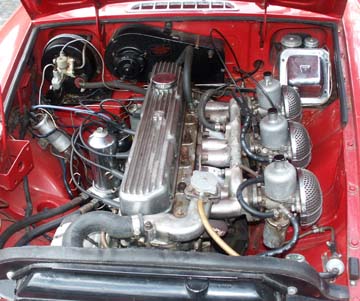
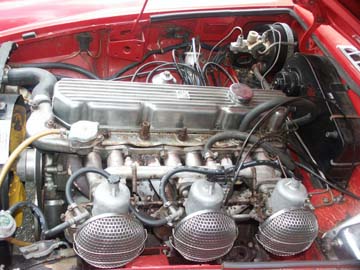
Back when I was seeing a lot of B20b Volvos, I solved a tremendous number of carb problems with some ignition work.

In reply to Carl Heideman :
Racing Jaguars with SU's I was given the opportunity to swap Webers in place of the SU's I was at 310 hp at 6000 rpm on the SU's then we removed the manifold and replaced it with Webers it took us 9 pulls to reach and pass the SU's By 15 horsepower @ 6000 rpm ( and a few torques, don't remember but not a lot)
If you look at the intake manifolds you can see exactly where that difference is. The Weber manifold is just about straight in while the SU manifold has sweeping curves going into each cylinder.
When I bolted the SU's back on I still had enough time to do a a little more testing. This time the difference was down to 12 horsepower. Looking at the air density I richened the SU's one flat. And the difference dropped to 11 horsepower.
We were out of time and I didn't want to spend enough for another hour. Which is what we figured it would take to get the SU's off and Webers on then adjust them.
The difference between the two carbs though is the ease of adjusting the SU's imparted to switching jets and air correction on the Webers.
While you might be able to change Webers in 10 minutes ( with a helper ) SU's can be adjusted in 2 minutes or so.

wspohn
SuperDork
2/23/22 9:52 a.m.
They are remaking the DU6 double barreled SUs I posted a pic of above, but they are not cheap! A couple of thousand per, quite often.
I like my Webers.Twin 40s one and single 45 on the other.Yes they can be a pain but you have to make sure the rest of the cars systems are correct.
In reply to wspohn :
TR4 intakes? I've got a triple intake manifold for my MGC-GT, do you think three 1 1/2" SUs, HS4s or HIF4s, on a mostly stock engine would be appropriate?

wspohn
SuperDork
5/4/22 11:58 a.m.
MGWrench said:
In reply to wspohn :
TR4 intakes? I've got a triple intake manifold for my MGC-GT, do you think three 1 1/2" SUs, HS4s or HIF4s, on a mostly stock engine would be appropriate?
Almost - TR4A, which used the longer runners and had smaller diameter runners (which came in handy when I had to grind them out asymmetrically to match the MGC port spacing).
I think that you can make triple 1 3/4" carbs run just fine on a pretty stock MGC engine with little or no modification. I built my engine with a mild cam, and home built headers, which with the new carb set up removed most of the things that hampered performance. The result was to move top speed from the stock 120 to 130 and still rising when my road ran out.
on both my early miura, 4.2 maserati indy, and 4.7 bora the cars cruised on the idle circuit to well over 60mph! on the bora a couple plugs kept fouling. i'd switch holes with a clean plug and go 1/8 turn lean on the idle screws of the offending cylunders. after 3 adjustments i could trundle thru town at barely over 1000rpm in 5th...not that i did that very often!

Where the Webers and SU's are nearly identical is the mixture requirements for any given application.
On a SU just look at the needle for that application. It's never a straight line. A smoothish curve is about the best you can hope for. But getting there is so much simpler then the Weber. The trick to meeting the fueling requirements for a Weber is the air correction selection.
That's probably why Ferrari's, Alfa's etc. don't respond as well to modification other cars do. The balancing act between air correction, accelerator pump, and Jets that Webers have is far harder to learn and understand. Even so called experts are guessing at this point.
With SU's as you get away from stock it's easy to see where things go lean or rich and adjust accordingly. Since most changes require additional fuel, a needle chucked into a drill will quickly polish down with a piece of 1000 grit emery paper. If you're anal you can then measure that spot and keep a record of the changes you made.
I pinch the needle where it's running lean. Stick a sharpie in and mark that spot on the needle and Bob's you Uncle.

wspohn
SuperDork
5/5/22 11:44 a.m.
tolyarutunoff said:
on both my early miura, 4.2 maserati indy, and 4.7 bora the cars cruised on the idle circuit to well over 60mph! on the bora a couple plugs kept fouling. i'd switch holes with a clean plug and go 1/8 turn lean on the idle screws of the offending cylunders. after 3 adjustments i could trundle thru town at barely over 1000rpm in 5th...not that i did that very often!
This was my Islero engine - V12 with 3 DCOEs per side.
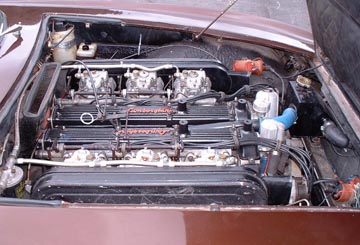
It was (obviously) finicky to tune from scratch but once done I could floor the accelerator in 5th gear at 1200 rpm, and it would pull smoothly away and could have accelerated without drama to the 170 mph region (I only tested it to c. 100 mph, being marginally sensible).
Like your Maseratis, once the tuning was done, the watchword was 'hands off'. More cars have been screwed up by people meddling with carbs when the problem lay somewhere else.
There are some amazing carb guys around, or at least there were. I was at Laguna Seca having an issue with the smooth running of twin 45 DCOEs on my MGA Twin Cam race car and this guy that looked like a street person came over to watch. He turned out to be a Weber guru, pulled the jets and showed me one out of 4 air corrector jets that someone had for some reason lightly countersunk the entry hole of. Swapped out for another one and the issue was cured. Likely never would have found it without that guy.
There are SU magicians out there too, and also for American cars ( I was lucky enough to find one when fine tuning a car I owned with a big block Chrysler with sixpack).

wspohn said:
tolyarutunoff said:
on both my early miura, 4.2 maserati indy, and 4.7 bora the cars cruised on the idle circuit to well over 60mph! on the bora a couple plugs kept fouling. i'd switch holes with a clean plug and go 1/8 turn lean on the idle screws of the offending cylunders. after 3 adjustments i could trundle thru town at barely over 1000rpm in 5th...not that i did that very often!
This was my Islero engine - V12 with 3 DCOEs per side.

It was (obviously) finicky to tune from scratch but once done I could floor the accelerator in 5th gear at 1200 rpm, and it would pull smoothly away and could have accelerated without drama to the 170 mph region (I only tested it to c. 100 mph, being marginally sensible).
Like your Maseratis, once the tuning was done, the watchword was 'hands off'. More cars have been screwed up by people meddling with carbs when the problem lay somewhere else.
There are some amazing carb guys around, or at least there were. I was at Laguna Seca having an issue with the smooth running of twin 45 DCOEs on my MGA Twin Cam race car and this guy that looked like a street person came over to watch. He turned out to be a Weber guru, pulled the jets and showed me one out of 4 air corrector jets that someone had for some reason lightly countersunk the entry hole of. Swapped out for another one and the issue was cured. Likely never would have found it without that guy.
There are SU magicians out there too, and also for American cars ( I was lucky enough to find one when fine tuning a car I owned with a big block Chrysler with sixpack).
Absolutely there are real magicians out there who know the shorts cuts to dealing with ( actual) carb problems.
But far fewer with Webers than SU's or American cars. It's just a matter of numbers rather than any bias.
Even racers who use Webers tend to try to find one of those and just leave it alone.
Which is a pity because the air is always changing and the skill of adjusting for that is where the power is.
EFI spoils us. It adjusts instantly and constantly.
But if you watch Sprint car racing. You'll often see the crew chief pass a signal. ( some get really clever, adjusting their hat. Holding an elbow, leaning one way or the other. Then the driver will reach down and move the dial a jet.
I saw Steve Kinser come from 5 positions back to win after such a signal. ( that's when I invested in my own Air density meter).

wspohn
SuperDork
5/6/22 11:24 a.m.
frenchyd said:
Then the driver will reach down and move the dial a jet.
The race organizations that I ran with tended to make rules that strangled modern measures (this was vintage racing) so they came down on people like a 914 that ran with me who was tuning his engine from the cockpit while driving using an air/fuel gauge and a cockpit control from the ECM.
I fitted an MSD ignition early on but hid it under the dash and also utilized a knock sensor on the engine coupled with a cockpit accessible control to vary ignition advance. I only used it in practice and then covered the gauges up so they weren't visible when going through tech.
Did it go faster with the maximum possible advance on a given day? Possibly, but my intention was to find the maximum safe advance wit the fuel in the tank and prevent potentially very damaging detonation by backing of a tad from that.
In reply to wspohn :
I'm thinking the reason to limit in-motion adjustments is to reduce the cost of engine development in Vintage racing. Although to be fair I was using the dial a jet back in the 1980's. With the open cockpit and a study of the weather patterns I could open my visor on the straight away and feel the weather on my face adjusting the jets accordingly.
Technology is so advance now that some cars have the potential to even in relatively stock configuration greatly exceed original performance.
With little more than a reground camshafts and a $100 EBay turbo charger Calvin was able to take a stock engine from a junkyard wreck with 175,000 miles on it and improve the horsepower from 290 to 824 horsepower.
He did that without removing the head or touching the bottom end.

wspohn
SuperDork
5/10/22 11:28 a.m.
As rules are liberally applied. there is a lot of 'variance' in mechanical spec locally.
All the Alfas I used to race against at Seattle, were carrying 1600 - 2000 cc engines - it was like the original 1300s had somehow evaporated. The early 911s used whatever they could get in there from a decade after they were built (I recall there being some line past which the substitution would have been too obvious, but don't recall what that line was - I think that the original 2000 cc engines 'grew' to 2.4 or so.
No trophies to win, no championship points, so why should the Bugeye owner run a grenade 948 cc engine when they could run a mild tune 1275 lookalike with around the same or more power and have it last indefinitely? And there were a few early Jag XKs that had engines that had somehow stretched to 3.8 or even 4.2 while retaining the appearance of a 3.4.....
In reply to wspohn :
Then there is the Chevy small block. So many of them started out with 283's and suddenly they were racing with 350's stretched to 400's or yes I even built a 430 for one of my customers.
The problem is with all those engines. Is it's so easy to tell a 948 from a 1275 or Various Porsches, Jaguars, etc.
But yes I'm guilty of it. A 283 I built I put a Target master (350) in it. And it was reliable enough to win 12 out of 13 races that season. But a 2nd instead of first justified going all the way to 430 ?




































